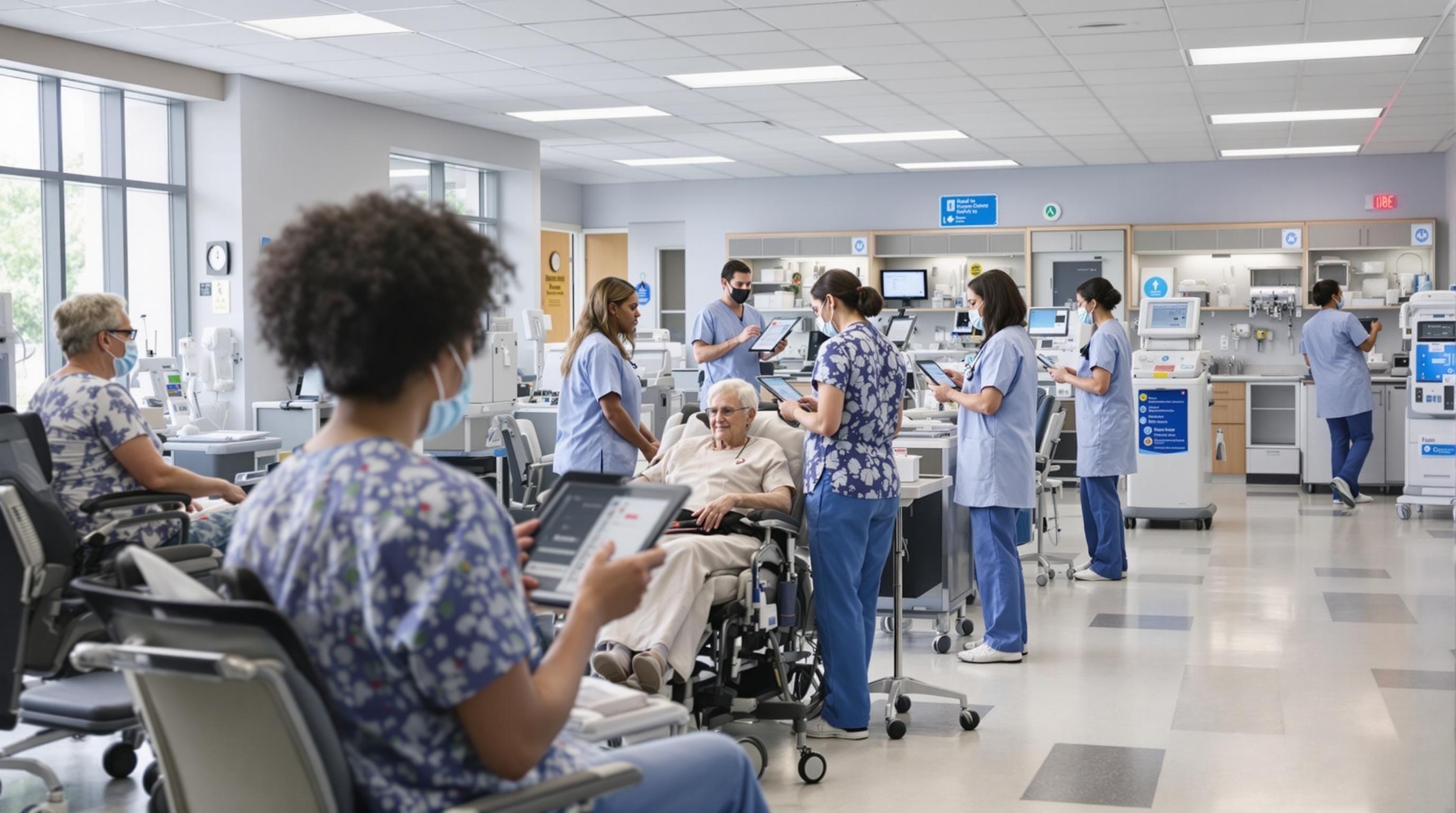Survey Readiness Software for SNF: Ensure Compliance & Efficiency
Discover how survey readiness software for SNF streamlines compliance, reduces risks, and keeps skilled nursing facilities prepared for inspections.
Quick Navigation
- 1. Introduction
- 2. Current Challenges in Survey Readiness Software For SNF
- 3. How Sparkco AI Transforms Survey Readiness Software For SNF
- 4. Measurable Benefits and ROI
- 5. Implementation Best Practices
- 6. Real-World Examples
- 7. The Future of Survey Readiness Software For SNF
- 8. Conclusion & Call to Action
1. Introduction
Did you know that workforce challenges are now the top concern for nearly half of skilled nursing facility (SNF) operators, directly impacting their ability to maintain quality care and meet regulatory demands? According to a recent industry survey, 45.5% of SNF leaders cite staffing constraints as the greatest threat to clinical excellence—surpassing even reimbursement and operational costs. In a landscape where regulations are constantly evolving and annual surveys can arrive at any time, the pressure to be “survey ready” every day has never been higher.
For SNF administrators, staying compliant isn’t just about passing an inspection—it’s about protecting residents, reputations, and reimbursements. Traditional methods for survey preparedness, like the time-consuming upkeep of survey binders and manual audits, simply can’t keep up with today’s pace and complexity. Staff turnover, documentation gaps, and overlooked policy updates can all lead to costly citations or penalties.
Enter survey readiness software: a new generation of digital solutions designed to ease the compliance burden and empower teams with real-time insights. In this article, we’ll explore how survey readiness software for SNFs transforms daily operations, streamlines documentation, and supports proactive, evidence-based care. We’ll examine key features, benefits, and best practices—helping you move from reactive scrambling to confident, continuous compliance. If you’re ready to future-proof your facility and reduce regulatory stress, read on to discover how technology can be your strongest ally.
2. Current Challenges in Survey Readiness Software For SNF
Skilled nursing facilities (SNFs) increasingly rely on survey readiness software to streamline compliance processes and prepare for regulatory inspections. While these digital tools promise efficiency and transparency, many healthcare organizations face significant challenges during implementation and daily use. Below, we examine the key pain points, supported by recent research and statistics, and discuss their operational impacts.
-
1. Integration Difficulties with Existing Systems
Many SNFs struggle to integrate survey readiness software with their Electronic Health Records (EHR) and other management systems. According to a 2023 ONC report, only 59% of SNFs had adopted certified EHRs, indicating a fragmented tech landscape. Lack of interoperability can lead to duplicate data entry, errors, and increased staff workload. -
2. Steep Learning Curves and Insufficient Training
Survey readiness platforms can be complex, requiring extensive training for staff. A LeadingAge survey found that 47% of SNF leaders cited inadequate staff training as a barrier to technology adoption. This can delay implementation, reduce user adoption, and create compliance risks when critical features are underused. -
3. Data Accuracy and Timeliness
Ensuring that data entered into readiness software is accurate and up-to-date remains a challenge. Discrepancies can lead to survey citations, which CMS data shows are rising—between 2019 and 2022, SNFs experienced a 15% increase in deficiencies related to inaccurate documentation (CMS FSQRS). Delayed or incorrect entries impact both compliance and patient care quality. -
4. Alert Fatigue and Overwhelming Dashboards
Survey readiness software often generates frequent alerts and action items. Excessive notifications can cause “alert fatigue,” leading staff to ignore important compliance reminders. According to a Joint Commission analysis, nearly 60% of surveyed facilities cited alert fatigue as a factor in missed compliance deadlines. -
5. High Implementation and Maintenance Costs
Budget constraints are a persistent issue. A Zira Medical review indicates that the average SNF spends $50,000-$150,000 on new software implementations, not including ongoing maintenance. This financial strain can limit technology upgrades and negatively impact operational efficiency. -
6. Regulatory Updates and Software Lag
Regulatory requirements for SNFs frequently change. Software vendors may lag in updating their systems to reflect the latest CMS or state regulations, exposing facilities to compliance risks. This lag can result in missed requirements and deficiencies during surveys. -
7. Limited Customization and Scalability
Many commercially available solutions lack flexibility to adapt to the unique workflows or size of different SNFs. Facilities with specialized needs or those scaling operations can find themselves constrained by rigid software features, leading to inefficiencies and workarounds.
These challenges collectively impact SNF operations by increasing administrative burden, introducing compliance risks, and diverting attention from direct patient care. Inaccurate or delayed documentation can compromise care quality, while overwhelming software interfaces contribute to staff burnout. Addressing these issues is crucial for healthcare leaders aiming to maximize the return on investment in survey readiness technology and ensure continuous regulatory compliance.
3. How Sparkco AI Transforms Survey Readiness Software For SNF
Skilled Nursing Facilities (SNFs) face ongoing challenges in maintaining survey readiness, from tracking compliance requirements to ensuring seamless documentation and training. Traditional methods often rely on manual processes, leading to missed deadlines, incomplete records, and increased risk of compliance violations. Sparkco AI is revolutionizing survey readiness through its advanced, AI-powered software designed specifically for SNFs. Here’s how Sparkco AI addresses these challenges and empowers facilities to stay always survey-ready.
-
Automated Compliance Tracking
Sparkco AI continuously monitors regulatory updates and automatically maps them to your facility’s policies and procedures. This ensures that administrators are instantly notified of any gaps or pending tasks, dramatically reducing the risk of oversights. Automation takes the guesswork out of compliance, keeping your SNF aligned with state and federal requirements at all times. -
Real-Time Audit Readiness Dashboards
The platform provides intuitive dashboards that display survey readiness metrics in real-time. Administrators can quickly view outstanding action items, upcoming deadlines, and overall compliance status at a glance. AI-driven insights highlight areas needing attention, allowing staff to prioritize efforts where they matter most. -
Intelligent Document Management
Sparkco AI streamlines documentation by automatically categorizing, tagging, and archiving survey-related files. Its smart search functionality enables users to instantly locate policies, training records, or incident reports, ensuring every document is audit-ready and accessible within seconds. AI minimizes manual filing errors and keeps your facility organized. -
Automated Staff Training & Competency Tracking
Ensuring staff are trained and competent is critical for survey success. Sparkco AI automates training assignments based on role, tracks completion, and provides reminders for upcoming or overdue training modules. The system also analyzes competency trends and suggests targeted learning opportunities, helping maintain a culture of continuous improvement. -
Customizable Survey Simulation & Mock Audits
Prepare for the real thing with AI-powered mock surveys tailored to your facility’s unique profile. Sparkco AI generates realistic scenarios and evaluates performance, providing actionable feedback to close any gaps before the actual survey. This proactive approach builds staff confidence and ensures readiness under pressure. -
Seamless Integration with EHR and HR Systems
Sparkco AI is designed for easy integration with existing Electronic Health Records (EHR) and Human Resources (HR) platforms. This ensures data consistency, eliminates duplicate entry, and allows for smooth information flow across all compliance-related processes.
By leveraging advanced AI and automation, Sparkco AI simplifies every aspect of survey readiness for SNFs. The platform’s user-friendly design and seamless integration capabilities ensure that staff can focus on providing quality care, confident that compliance requirements are always up to date and audit-ready. Sparkco AI transforms survey preparation from a stressful scramble into a streamlined, proactive process—setting a new standard for skilled nursing excellence.
4. Measurable Benefits and ROI
ROI and Measurable Benefits of Automated Survey Readiness Software for Skilled Nursing Facilities (SNFs)
The regulatory environment for Skilled Nursing Facilities (SNFs) is complex, with frequent surveys and stringent compliance expectations. Automated survey readiness software is transforming how SNFs manage compliance, documentation, and survey preparation. By digitizing and streamlining essential processes, these solutions deliver a range of measurable benefits that directly impact operational efficiency, regulatory outcomes, and the bottom line.
-
Significant Time Savings: Automated survey readiness software reduces staff time spent on survey preparation by up to 60%. According to a PointClickCare case study, facilities reported reducing their pre-survey preparation from over 100 hours to less than 40 hours per survey cycle.
-
Cost Reduction: Decreased overtime and administrative hours translate into substantial cost savings. Facilities adopting digital readiness tools have reported lowering compliance-related administrative costs by 20-30% annually, as detailed in a HealthIT.gov report.
-
Improved Survey Outcomes: Automated tracking and real-time alerts help ensure critical tasks and documentation are completed, reducing the risk of deficiencies. A JAMDA study found that facilities using compliance software experienced a 35% reduction in survey deficiencies over a 12-month period.
-
Enhanced Regulatory Compliance: Automated solutions ensure timely completion of required assessments, policies, and training. Facilities have increased their on-time compliance task completion rates from 70% to over 95% after implementing readiness software (Medline Survey Readiness Guide).
-
Real-Time Data and Analytics: Software platforms provide actionable analytics on compliance trends, staff performance, and outstanding issues. Facilities using these analytics have reported a 50% faster resolution of compliance gaps, improving overall readiness.
-
Staff Satisfaction and Retention: By automating tedious manual tracking, staff stress is reduced. A study in BMC Health Services Research noted a 22% improvement in staff satisfaction and retention in SNFs adopting process automation.
-
Risk Mitigation and Fines Avoidance: Avoiding survey deficiencies can help SNFs steer clear of costly fines. According to Skilled Nursing News, the average fine for survey non-compliance can exceed $15,000 per incident—costs which robust readiness software can help prevent.
-
Centralized Documentation and Audit Trails: Digital solutions provide a single source of truth for all compliance documents, improving audit readiness and transparency. Facilities report a 70% reduction in lost or incomplete records (Relias).
The combined effect of these benefits is a demonstrable return on investment, with many SNFs reporting positive ROI within the first year of implementation. As regulatory scrutiny and staffing challenges persist, automated survey readiness software is proving indispensable for both operational resilience and regulatory success.
5. Implementation Best Practices
Implementing survey readiness software is a strategic move for skilled nursing facilities (SNFs) aiming to streamline compliance, prepare for CMS surveys, and enhance overall quality of care. To ensure a successful rollout, follow these actionable steps, practical tips, and change management considerations:
-
Assemble a Cross-Functional Implementation Team
Include representatives from nursing, administration, IT, and compliance to ensure all perspectives are addressed. Tip: Assign a project lead to drive accountability. Pitfall: Neglecting stakeholder input can result in low adoption and missed requirements.
-
Define Clear Objectives and Success Metrics
Establish what you want to achieve—e.g., timely audit completion, improved documentation, or reduced citation risk. Tip: Align goals with CMS’s latest survey priorities and internal compliance needs. Pitfall: Vague objectives make it hard to measure success and maintain focus.
-
Conduct a Workflow Assessment
Map current survey preparation processes to identify gaps and areas for automation. Tip: Involve staff performing daily audits to surface real workflow challenges. Pitfall: Failing to understand existing workflows may result in software misalignment.
-
Customize the Software to Facility Needs
Configure checklists, notifications, and dashboards to reflect your facility’s policies and CMS requirements. Tip: Use templates from software vendors as a starting point, then tailor them. Pitfall: Relying solely on out-of-the-box settings may result in incomplete compliance coverage.
-
Provide Comprehensive Staff Training
Deliver hands-on sessions and job aids for all user levels. Tip: Offer refresher training and onboard new hires quickly. Pitfall: Assuming staff will self-learn can lead to inconsistent usage and data entry errors.
-
Establish Ongoing Monitoring and Support
Designate support contacts and schedule regular check-ins to review usage data and address issues. Tip: Leverage vendor support and user communities. Pitfall: Ignoring ongoing support needs can cause user frustration and system abandonment.
-
Solicit Feedback and Iterate
Encourage staff to share feedback and suggestions for improvement. Tip: Create a simple process for users to report challenges. Pitfall: Failing to act on feedback can erode trust and participation.
-
Integrate Change Management Strategies
Communicate the “why” behind the software, address concerns, and celebrate early wins. Tip: Appoint change champions among frontline staff to foster buy-in. Pitfall: Overlooking change management can breed resistance and slow adoption.
By following










